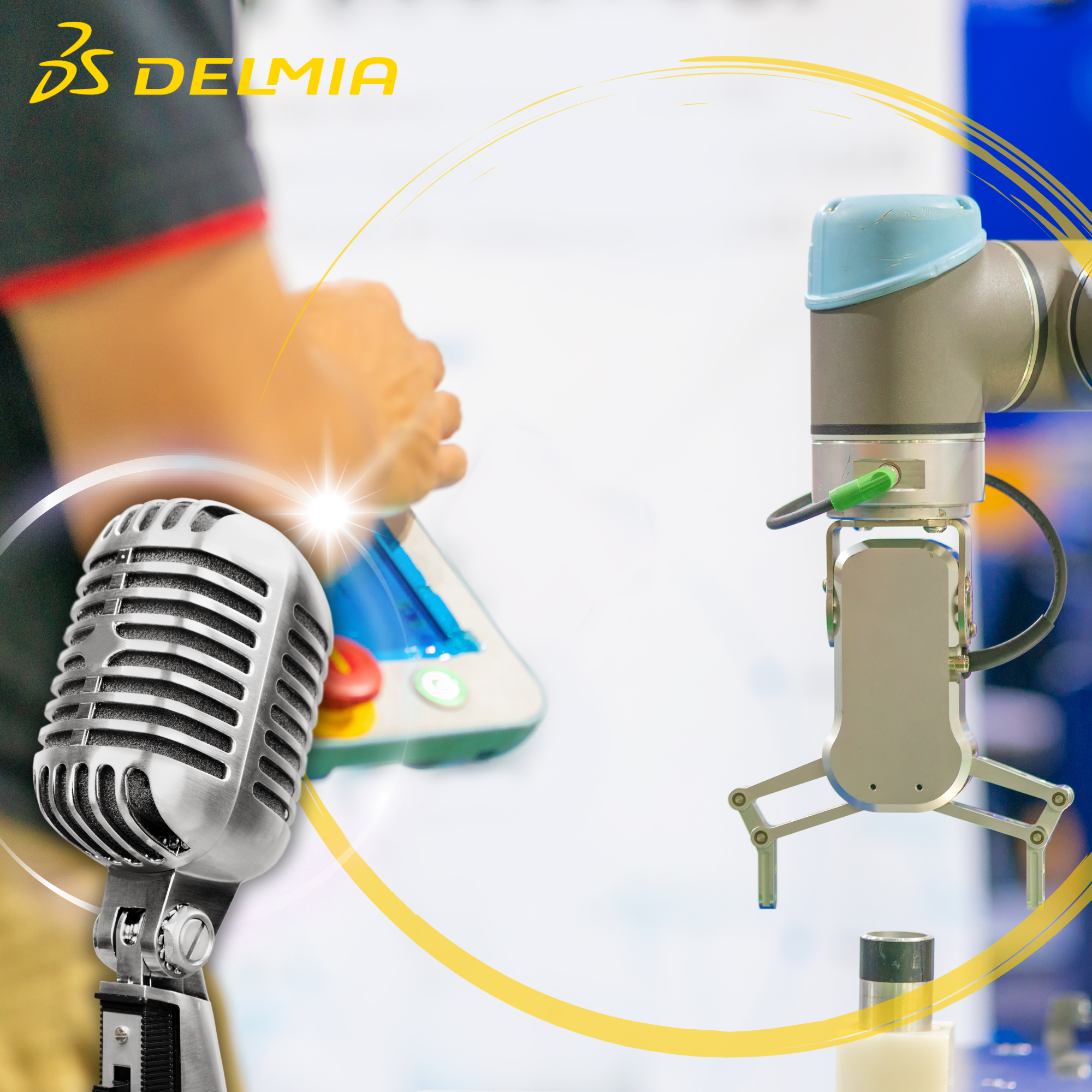Ep: 31 Cobotics – The Next Evolution of Industrial Robots
Loic Sandras, DELMIA Industry Process Consultant, Operations Engineering, discusses how cobots can improve your operations, divide the robotic domain into different collaborative levels, and why the virtual twin plays such a big role.
Cobot interaction aids in difficult and hazardous operations
You may have seen them at industry shows or heard about them in meetings, but what do you really know about cobots? Collaborative robotics, known as cobotics, is a branch of robotics used to collaborate with operators and address difficult operations. Cobots are changing the way people work in factories by allowing increased interaction between robots and humans. For instance, a cobot, which can be seen as a more compliant version of an industrial robot, are able to work autonomously on repetitive and hazardous tasks. It can have slower speed limits, soft edges, and sometimes protective shapes mounted on it, to name a few advantages. With a cobot in play, workers are free to then perform more complex and higher-valued tasks. Tune in to this podcast to discover how cobots are reshaping the industry.
Discover more on cobots:
Meet Our Speaker
Loic Sandras
DELMIA Industry Process Consultant, Operations Engineering
You can follow the DELMIA "Global Operations on the Go" podcast on Apple podcasts, Spotify, YouTube Podcasts, Deezer, by RSS or wherever you get your podcast


![]()


Therese (00:05):
Welcome to our DELMIA podcast, Global Operations on the Go! Today we’re going to dive into the topic of Cobotics with Loïc Sandras. Loïc is a DELMIA Industry Process Consultant, Operations Engineering. He has joined the company recently, starting by working on Cobotics with the R&D team.
Loic (00:28):
Hi Therese! Thank you for the invitation to this podcast.
Therese (00:32):
Oh, absolutely. My pleasure. Glad that you can make it. So to get started, can you please tell our listeners what exactly is cobotics?
What is cobotics?
Loic (00:42):
Sure. The expression cobotics comes from the contraction of two words: collaborative and robotics. That's why we also talk about collaborative robotics. So robotics is a branch of robotics where the cobot is thought to assist the human to collaborate with operators, help him realize difficult operations. And this is mainly possible because a cobot is a more compliant evolution of an industrial robot with smaller limits, speed limits, soft edges, and sometimes protective shapes directly mounted on it. They are really, really trendy and if you have ever been to an industry event, you have probably seen a lot of them.
Therese (01:22):
Oh yeah, absolutely. From my own knowledge, yes, I do recall those. Very cool indeed. So as you mentioned—“trends”--there's a trend that robotics will one day replace operators on their tasks. Some fear, in fact, that they could lose their jobs over this. Is that fear legitimate?
Working together with operators
Loic (01:42):
Well, to be honest, this is not only about losing some jobs. So, to be completely honest, this idea that robots will replace some work is not 100% false, but we don't need to be afraid of that. And it's even quite the opposite because cobots are thought to replace operators on the tedious, repetitive, and painful tasks. In case, they can replace the non-added value activities so the workers can focus their mind and responsibilities on tasks with more added value-- and those that are less dangerous. This is really the strength of cobots and robotics. What is important to have in mind is that robots or cobots are high- level technologies. The use of robots will create a new need for new skills, less risky, which has a real interest in the world that we live in with this focus on operators physical health.
Therese (02:36):
Alright, definitely, definitely important and good points. Thanks for the detailed answer. Clearly we can understand that cobots are here to help us more than replace us—so that's a very good example. Can you explain in more detail what the difference is between a cobot and an industrial robot?
The 3 main collaborative levels
Loic (02:54):
Well, we often divide the robotic domain or the overall domain into three different collaborative levels. So the level zero, the first one is basically the industrial robots. They are fast, they carry EV and bulk kilos. And trust me, you really don't want to cross the path on the of an industrial robot. That is why we can see them in high-security cages. The first level is the coexisting robots. These are often industrial robots, basically the same one, but for which physical security have been replaced by present sensors. The operator can go to work next to the robot, but if it gets closer, the sensor will make the robot slow down until stopping it completely at a certain level of proximity. We also see industrial robots. We've added skin technologies to soften the edges. In case of a collision, the damages will be drastically reduced.
Loic (03:50):
The second level of collaborative robotics is the real, what we call the collaborative robot, the cobot. This one is supposed to be self-sufficient To ensure the safety of the operators in its surrounding, it needs to respect the standard ten two hundred eighteen. So which is the worldwide standard created for collaborative robots. The safety measure can be either internal or sensors to detect the shock and stop the cobots instantaneously or externally measure that is mainly managed with branded edges. That gives the particular shapes of cobots that we often see in the cobots in the market. An important thing is that the robots must be collaborative also with the tool he will carry.
Therese (04:33):
No, I think that makes perfect sense with the tooling, especially when it comes to regard to sensors and safety, all collaborative, right, all part of the same process. So having that in mind, Loic, can you explain additional advantages of the cobots?
Offering versatility and flexibility
Loic (05:15):
Well, the main advantages of cobots is that they are more versatile and flexible than an industrial robot. So it's really much easier to move the cobot from one station to another, reprogram it to perform another task. And moreover, to install a cobot in production, you don't need to install physical security. So it's a huge gain of time, money, and space. The next advantage, as we already discussed, is that the cobot will be able to assist the operator in its activities. So for example, to carry the non-added value tasks at the same works workplace as worker or to perform activities in hard to reach places under car body, for example. However, billing collaborative means that both the speed and the payload limits must be drastically reduced compared to an industrial robot. That's why cobots are not suitable for all use cases. While thinking about cobot implementation, the objective must be to improve the operator work conditions because it'll certainly not increase the productivity. So it's really important for end users to study the integration possibility, especially with DELMIA and the 3DExperience platform.
Therese (06:27):
I think that's a great point. The integration, especially with, as you said, DELMIA, that you're able to introduce our DELMIA solutions, in fact. So in your own words, can you explain what we can propose to our customers to take part of the cobot integration study?
Loic (06:48):
Cobots have the advantage of being easy to program online. However, simulation can have a huge advantages for validation and testing before onsite commissioning. That is why we will recommend to use DELMIA 3DExperience. With DELMIA, you can reproduce the virtual twin of the station, thus you can use this virtual twin to simulate robot trajectories. Human activities use sensors to detect cobot human proximity, so you can validate your entire line before the implementation. Being sure that what you will send to the shop floor will be a hundred percent compliant with the requirements. The virtual twin can also be used to compare the performances between the cobot and an industrial robot to validate if the cobot couldn't insert the need that you will have to answer before to invest on the cobots and online modifications. In addition, with our virtual commissioning capabilities, you can anticipate the programming and synchronization of all the logical controller and validate every “what if” scenarios.
The 3DExperience possibilities
Loic (07:52):
Virtual commissioning is today not negligible to train operators and to help the acceptance on the shop floor. Moreover, in DELMIA, you also have the possibility to use solutions to analyze operators ergonomics and given activities. You can use DELMIA to see which human a operation mean, which may requires the help of a cobot and validate the collation if feasible. So this is a simple non exhaustive list of what are the capability that we can bring to our customers with DELMIA, 3DExperience and of course we have a lot more capabilities. So if some of the listeners are interested in our solutions to cover this cobotics subject, we can have a more detailed discussion on the entire portfolio that we offer.
Conclusion
Therese (08:42):
Yes, that's fabulous. And in fact, our listeners can access information on the main podcast page.
It has been really interesting to hear about cobotics and bringing in virtual twin and virtual commissioning into the subject. Thank you so much for taking the time to speak with me today!
Loic (09:01):
Thank you Therese for the time and giving me the opportunity to talk about this trendy topic of cobotoics.
Therese (09:08):
Oh, absolutely. Thank you. And thanks to our listeners for tuning in. For more information just look for the link where the podcast is hosted. I'm your host, Therese Snow, and you've been listening to DELMIA’s Global Operations on the Go!


